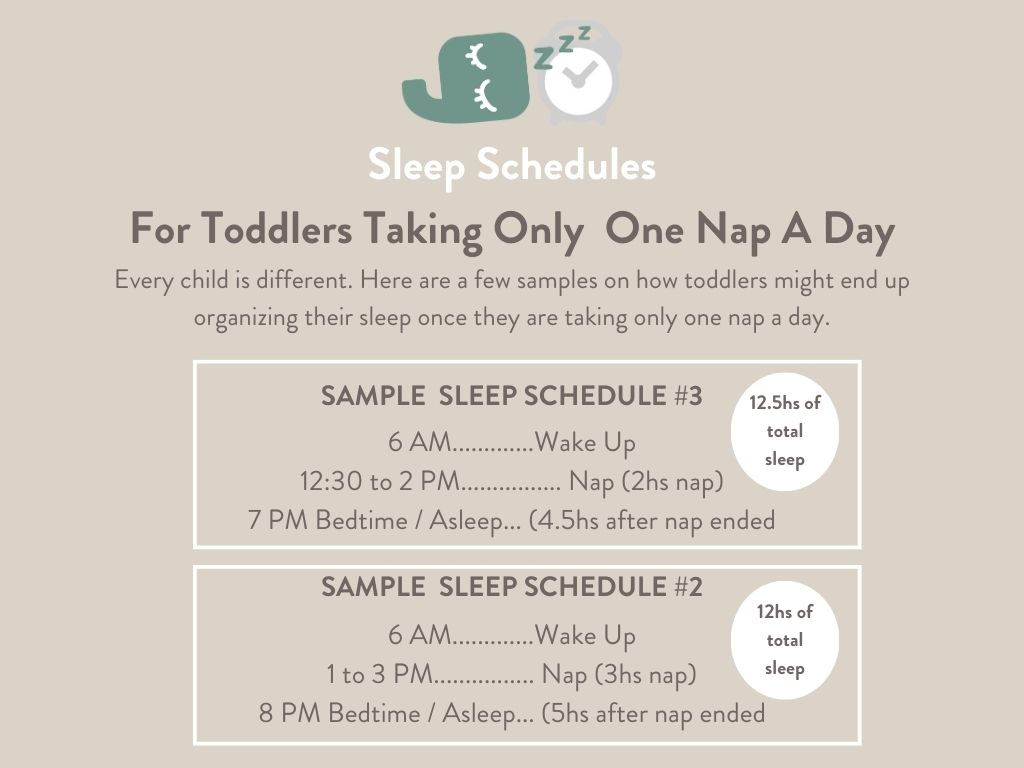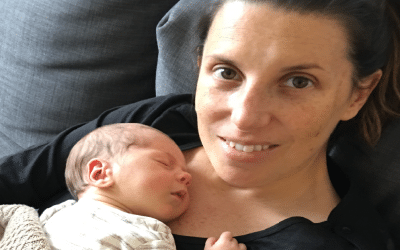Just when you thought you had your baby’s sleep schedule figured out, life throws you another curveball.
It’s time to start the transition to one nap a day.
Don’t panic! This guide will help you understand your baby’s sleep needs as they grow and create a plan to help them adjust to a one nap schedule.
Understanding your little one’s sleep is the best way to help them get better sleep. But we know it can be challenging to figure it all out alone.
When should I start transitioning my baby from 2 naps to 1?
Most babies are ready to transition from two naps to one between 14-18 months of age. Some babies are ready as early as 12 months, but this isn’t common.
By 18 months old most toddlers have transitioned to one nap a day.
While it’s important not to rush this transition, keeping two naps for too long isn’t good either. As your little one grows, having two naps can push bedtime too late and affect the quality of nighttime sleep.
Signs your baby is getting ready to have a 1 nap schedule.
One week your baby was getting two amazing naps a day, and the next, their schedule seemed to be all over the place. This might be a sign that they are ready for changes in their sleeping schedule.
What happens before the transition from 2 naps to 1:
- Your baby starts rejecting the morning nap. You offer the nap at their regular time, but they aren’t tired and take a long time to fall asleep.
- Naps become shorter, and your baby only sleeps for 30 minutes or less.
- The second nap becomes a problem. Your little one takes a morning nap, then rejects the second nap, or falls asleep much later in the afternoon.
- Your baby starts waking up more often during the night or is ready to start the day before 6 am.
When one or all these things happen, and your baby is 14 months or older, it’s time to start transitioning to one nap a day.
How do you transition from 2 naps to 1?
Move slowly.
Even though your child might be ready to drop the morning nap, adjusting to a new schedule and spending more hours awake is hard. To help them transition, gradually shift the morning nap later and later. Start by offering the morning nap around 10:30 am. Every 2 to 3 days, push the nap back 15 minutes until you reach 12:00 pm. This is usually a natural time when toddlers feel tired and are ready for sleep, especially children who wake between 5:30-7 am.
Avoid a late second nap.
As you move the morning nap back, the second nap will also start later in the day. You might find yourself with a toddler taking a second nap after 4 pm. However, allowing a late second nap will push bedtime later. Before you know it, it’ll be 10 pm, and your toddler will still be wide awake with no signs of tiredness.
For this reason, don’t let the second nap start after 2 pm. If your child is not tired by then, offering a super early bedtime, as early as 5:30 pm is best.
Early bedtimes will be your ally.
There is a lot of evidence to suggest that early bedtimes are better for young children. When your toddler took two amazing naps, you might have noticed they could tolerate later bedtimes. When toddlers move from 2 naps to 1, offering them earlier bedtimes is best.
During nap transitions, the body is adjusting to a new schedule. Even babies who are ready for this change will struggle and feel super tired at the beginning. The best way to support this transition is to make sure they don’t stay up too late. Putting them to bed earlier will help avoid overtiredness.
I usually recommend doing bedtime 4.5 hrs after the nap ends or as early as 5:30 pm at the beginning of the transition, when the nap ends too early or it’s too short.
Give it time.
Settling into a new schedule takes time. While your baby transitions from 2 naps to 1, you will feel like their schedule is “all over the place.” Some days they will take a long nap; other days, they might only sleep for 45 minutes.
Give it time and stay consistent. It might take a couple of months before the new schedule becomes regular.
You can expect your child to consolidate 2 naps into 1. So if they took two 1.5 hr naps before, you might see them settle into one 3 hr nap. Remember, every child is different, and sleep needs change from child to child. Some children need a 3 hr nap, and others will be ok after only sleeping for 1-1.5 hrs.
Keep a consistent schedule, even on the weekends.
A child’s biological clock (and adults, too) are oblivious to the concept of weekends. This means that our needs don’t change from Thursday to Saturday. We still need to eat and sleep every day. This is especially important for young children.
It might be tempting to skip a nap over the weekend or put your little one down later than usual. If you’re out and about, you might even be tempted to make bedtime later. These changes will harm your child’s sleep quality. Ideally, you want to respect your child’s sleep needs, even on the weekends.
Keep your baby in the crib
As your toddler grows, you might wonder if it’s time to move him from a crib to a regular bed. The recommendation is to wait until your child is at least 3 years old. Before 3 years of age, your child might struggle to relax at bedtime if the limits of the crib are not present. It will be difficult for them to sleep on a regular bed with access to the full room or house.
While every change can happen with consistency, it’s better not to start this change until after your child has transitioned from 2 naps to 1.
Understand your baby’s sleep needs.
Children 1 to 2 years old need between 11-14 hrs of sleep (between nighttime and daytime sleep). Sleep needs change from child to child, but every child has regular sleep needs. The way they distribute these hours between daytime and nighttime is also particular for each child.
While some children take a long 3 hr nap and then sleep 10 hrs a night, others might only need a 2 hr nap and 10-11 hrs a night.
When your child is following a healthy, age-appropriate schedule, they will naturally sleep enough, respecting their own specific sleep needs.
When toddlers transition to one nap a day, the recommended start time for this nap is 12 pm (noon). Let your child sleep for a maximum of 3 hrs during the day and start bedtime 4.5-5 hrs after the nap ends.
Here are some sample schedules for when your little one is ready to transition to one nap. Just remember, schedules and total amount of sleep needed will vary from child to child:
As you offer the nap at the right time, your child’s sleep schedule will develop naturally.
Keep offering the nap until at least 3 years of age
The age when children are ready to drop a nap varies greatly. Some children drop their nap close to 3 years old, while others might need it until they are 4 or 5.
Not only do young toddlers need to nap to restore their energy but studies have shown that napping has a positive impact on memory consolidation and learning in preschool children.
Even when your child is tired, they might refuse to nap.
It’s important to keep a healthy sleep routine to allow your child to sleep.
If you find that your little one is still struggling through the transition from two naps to one and you’d like personalized support through this transition, I’m here to help. Set up a one-on-one call with me and let’s work together to achieve improved nighttime sleep and consolidate daytime napping for your child.










